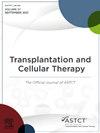Real-World Analysis of Barriers to Timely Administration of Chimeric Antigen Receptor T cell (CAR T) Therapy in Diffuse Large B-cell Lymphoma.
IF 3.6
3区 医学
Q2 HEMATOLOGY
引用次数: 0
Abstract
BACKGROUND The implementation of CAR T therapy in the real-world setting is hindered by logistical and financial barriers, impacting timely access to this life-saving treatment. Clinical trials have reported the time from leukapheresis to CAR T cell infusion (vein-to-vein time) but not the time from CAR T referral to infusion (decision-to-vein time). OBJECTIVE Herein, we report the barriers to CAR T therapy in a real-world setting. We evaluated the factors influencing the decision-to-vein time and explored the association with clinical outcomes in patients with relapsed or refractory DLBCL who received CAR T therapy. STUDY DESIGN We conducted a retrospective study of adult patients with R/R DLBCL who underwent consultation for CAR T cell therapy at Levine Cancer Institute and Wake Forest Comprehensive Cancer Center and collected information regarding demographic data, referral type, insurance type, CAR T product and survival outcomes. The effects of variables on decision-to-vein time were analyzed by Fisher's exact test for categorial variables and Wilcoxon rank-sum test for continuous variables. Survival analyses were performed using Kaplan-Meier and Cox Proportional Hazard models. RESULTS The study included 142 patients who were referred for CAR T of which 99 patients received CAR T. Median decision-to-vein time was 62 days compared to median vein-to-vein time of 32 days. Patients with private insurance took longer to obtain financial clearance compared to patients with government insurance (median 25 vs. 9 days, p < .001). Of those with private insurance (n=63), 35% needed a single case agreement (SCA) which led to significant delay in receiving financial clearance (median 50.5 vs.19 days, p < .001) and increased decision-to-vein time (median 75 vs. 55 days, p < .001) compared to those who did not need SCA. Decision-to-vein time was significantly different among various products, clinical trial being the shortest (median 47 days, n = 9) and non-conforming products being the longest (median 94.5 days, n = 6) (p< .001). Axi-cel had the shortest median decision-to-vein time at 61 days compared to 81 days with tisa-cel and 85 days with liso-cel. Although delays in receiving CAR T therapy did not impact survival, the median overall survival for patients who were referred for CAR T therapy but did not receive it, was significantly lower than those who received CAR T cell therapy (9.0 vs. 21.0 months, p < .001). CONCLUSION Decision-to-vein time is a major cause of delay in receiving CAR T therapy. SCAs lead to significant increase in 'decision-to-vein' time leading to delays in CAR T therapy in a real-world setting. Patients who were referred for CAR T but are not able to receive it, have inferior survival compared to CAR T recipients. Our findings underscore the significance of addressing administrative hurdles, such as SCAs and insurance approvals, for timely access to CAR T therapy for patients with DLBCL.对弥漫性大 B 细胞淋巴瘤患者及时接受嵌合抗原受体 T 细胞 (CAR T) 治疗的障碍的真实世界分析。
背景CAR T疗法在现实世界中的实施受到后勤和财务障碍的阻碍,影响了这种救命疗法的及时获得。临床试验报告了从白细胞分离到 CAR T 细胞输注的时间(静脉输注时间),但没有报告从 CAR T 转诊到输注的时间(决定输注时间)。我们评估了影响决定到输注时间的因素,并探讨了接受 CAR T 治疗的复发或难治性 DLBCL 患者的临床结局与决定到输注时间的关系。研究设计我们对在莱文癌症研究所和维克森林综合癌症中心接受 CAR T 细胞治疗会诊的 R/R DLBCL 成年患者进行了一项回顾性研究,并收集了有关人口统计学数据、转诊类型、保险类型、CAR T 产品和生存结局的信息。对分类变量采用费雪精确检验,对连续变量采用Wilcoxon秩和检验,分析变量对决定到输液时间的影响。结果研究纳入了142名转诊为CAR T的患者,其中99名患者接受了CAR T。与有政府保险的患者相比,有私人保险的患者获得财务许可的时间更长(中位数为 25 天对 9 天,p < .001)。与不需要单病例协议(SCA)的患者相比,有私人保险的患者(63 人)中有 35% 需要单病例协议(SCA),这导致获得财务审批的时间明显延迟(中位数为 50.5 天对 19 天,p < .001),从决定到静脉输注的时间增加(中位数为 75 天对 55 天,p < .001)。不同产品的决定到静脉时间有显著差异,临床试验产品最短(中位数 47 天,n = 9),不合格产品最长(中位数 94.5 天,n = 6)(p< .001)。Axi-cel从决定到静脉注射的中位时间最短,为61天,而tisa-cel为81天,liso-cel为85天。虽然接受 CAR T 疗法的延迟并不影响生存,但转诊接受 CAR T 疗法但未接受治疗的患者的中位总生存期明显低于接受 CAR T 细胞疗法的患者(9.0 个月 vs. 21.0 个月,p < .001)。在现实世界中,SCA 导致 "决定到静脉 "时间大幅延长,从而导致 CAR T 治疗的延迟。与接受CAR T治疗的患者相比,转诊接受CAR T治疗但未能接受治疗的患者生存率较低。我们的研究结果强调了解决行政障碍(如SCA和保险审批)对DLBCL患者及时获得CAR T疗法的重要性。
本文章由计算机程序翻译,如有差异,请以英文原文为准。
求助全文
约1分钟内获得全文
求助全文
来源期刊

Transplantation and Cellular Therapy
Medicine-Hematology
CiteScore
7.00
自引率
15.60%
发文量
1061
审稿时长
51 days
 求助内容:
求助内容: 应助结果提醒方式:
应助结果提醒方式:


